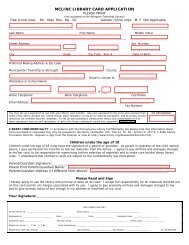Montgomery County Cyberbullying/Bullying Task Force - Horsham ...
Montgomery County Cyberbullying/Bullying Task Force - Horsham ...
Montgomery County Cyberbullying/Bullying Task Force - Horsham ...
Create successful ePaper yourself
Turn your PDF publications into a flip-book with our unique Google optimized e-Paper software.
Background and Definitions<br />
<strong>Bullying</strong> is a serious problem in homes, schools and communities; however, there is strong evidence<br />
that young people often do not report bullying to adults. Research clearly indicates bullying is a<br />
learned behavior and detrimental to the academic, physical, social and emotional development of all<br />
involved – bullies, targets and bystanders who witness it. Despite volumes of research, countless “antibullying”<br />
programs and increased scrutiny by the media, bullying continues to pervade our culture and<br />
our schools. It is a complex social issue requiring determination, leadership and courage to address. A<br />
wave of recent bullying incidents with tragic outcomes has shed a renewed light on the issue. The<br />
advent of technology allowing for impulsive, anonymous and rapid communication has expanded the<br />
opportunities for bullying to a degree that necessitates more innovative and immediate responses than<br />
ever before. 1<br />
<strong>Bullying</strong>:<br />
The Pennsylvania’s <strong>Bullying</strong> Prevention Toolkit defines bullying as “a form of aggressive behavior<br />
that is prevalent among children and adolescents. It is characterized by three features:<br />
1. The aggressive behavior is intentional and may be physical, verbal or nonverbal.<br />
2. An imbalance of power exists in the relationship, such that the person who is targeted has<br />
difficulty defending himself or herself.<br />
3. The behavior is repeated or severe, causing distress or disruption in the target’s life. 2<br />
<strong>Cyberbullying</strong>:<br />
<strong>Cyberbullying</strong> is a specific form of bullying that involves technology. According to Hinduja and<br />
Patchin, cyberbullying is “willful and repeated harm inflicted through the use of computers, cell<br />
phones and other electronic devices.” 3<br />
While the definition of cyberbullying aligns with the traditional definition of bullying, the likelihood of<br />
repeated harm from one cyberbullying incident is quite high. This is because instances of<br />
cyberbullying can be accessed by multiple parties, forwarded to others, linked to other sites, and<br />
revisited by targets of the aggression – resulting in repeated exposure and repeated harm.<br />
Examples of cyberbullying may include:<br />
• Stealing someone’s online name and using it to write nasty rumors, comments, or gossip.<br />
• Altering someone’s message or doctoring pictures to mean something different or poke fun.<br />
1 Berlin, Robert and Ruscitti, Darlene, Best Practices in <strong>Bullying</strong> Prevention and Intervention. A collaborative effort of the<br />
Dupage <strong>County</strong> Regional Office of Education and State’s Attorney ‘s General Office. January 2011<br />
www.dupage.k12.il.us/main/anti-bullying/.../BestPracticesManual.pdf<br />
2 Pennsylvania <strong>Bullying</strong> Prevention Toolkit; Resources for Parents, Educators, and Professionals Serving Children, Youth<br />
and Family. Center for Safe Schools, Highmark Foundation. www.SafeSchools.info/BP_Toolkit.pdf<br />
3 Hinduja, S. & Patchin, J. W. (2011). <strong>Cyberbullying</strong>: A review of the legal issues facing educators. Preventing School<br />
Failure: Alternative Education for Children and Youth, 55(2), 71-78.<br />
3





